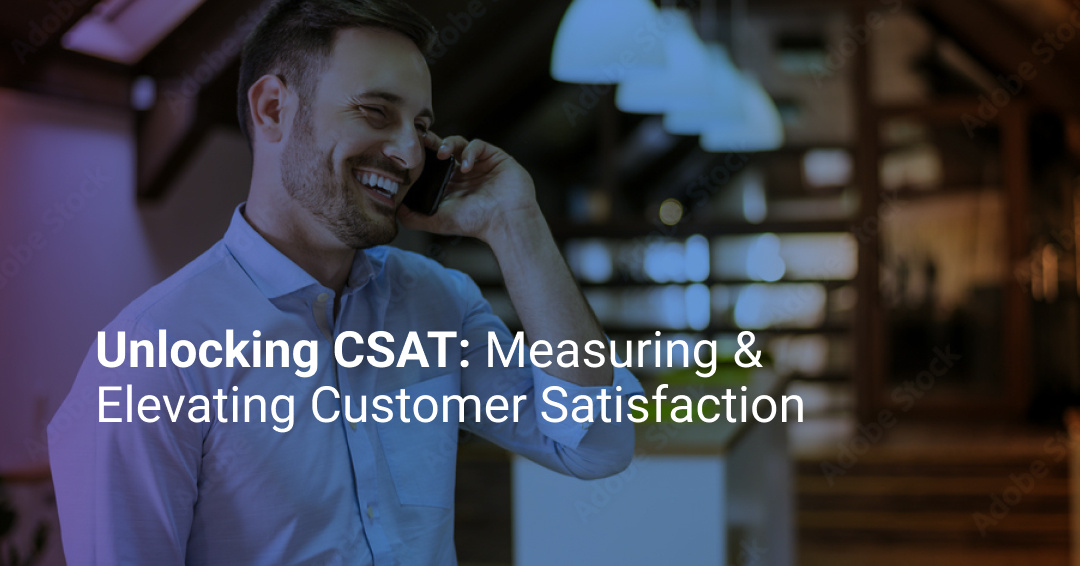12 Call Center Metrics You Should Be Using to Improve CX in 2025
Call center metrics are the most important performance indicators that monitor how effectively your call center is running. This includes anything...
Business growth and success hinge on customer satisfaction and loyalty, which makes customer experience (CX) a critical focus for many businesses. Organizations across industries pay millions of dollars to fund CX efforts to ensure customer satisfaction using Net Promoter Scores (NPS) as the primary KPI to measure their success.
In this entry, we will discuss the importance of NPS scores and the actionable steps you can take to improve them.
Net Promoter Score is a metric used in CX programs. It measures customer loyalty by asking one key question: “How likely is it that you would recommend [Organization/Product/Service] to a friend or colleague?”
Customers respond to the survey with a rating between 0 (not at all likely) and 10 (extremely likely). From there, the survey sorts respondents into one of three categories based on the types of customer feedback they share:
It’s important to collect different types of customer feedback because it can move the needle for businesses, transforming customers into brand advocates.
Understanding what makes or breaks your digital experience for your customers is the first step to identifying growth opportunities, reducing churn, and identifying potential problems. NPS is important because it is a relatively simple metric that can easily be included in your company to better understand your customers.
On top of that, NPS provides a clear and quantifiable perspective on how likely customer recommendations are for your business. This is vital, given that you can confidently measure what works and what doesn't and run CX experiments to find ways to improve your score.
There are multiple ways to improve your NPS and create a memorable experience for all your customers. Below, we will discuss some ways CX professionals can enhance the overall experience of their customers.
Remember that you ask customers to spend some time filling out your NPS score survey. Addressing their concerns quickly is a must.
While this may not improve your current NPS today, the fact that you have built a system to reach out to customers, especially those with negative feedback, positions your company differently. With the proper follow-up, even detractors are more likely to perceive your product or service differently, given that their concerts are taken seriously.
Gathering NPS scores at the right time is essential to ensure accurate and actionable results. While there are many things you could consider to pinpoint the right timing, generally, NPS scores are more useful right after a critical interaction such as a purchase or customer service call. This guarantees a fresh customer experience, leading to better data and detailed feedback regarding a vital interaction.
The standard NPS question, “How likely are you to recommend our product/service to a friend or colleague?” provides a quantitative score that can be helpful in determining what to improve, but it does not provide details about why a customer feels that way.
This is why follow-up questions are essential. They ensure that CX professionals understand what influences the rating and what the context for satisfaction or dissatisfaction is in order to improve. While there are multiple questions you could ask, what matters primarily is to identify context and opportunities and even allow customers to participate actively in your experience design. Remember that customers may not be willing to have long discussions, meaning prioritizing precisely what you want to discover is essential before approaching them.
Another critical aspect of improving NPS scores is identifying the root causes of customer issues. While there may be multiple reasons and touchpoints that can be improved, generally, these are symptoms of a much larger problem that needs to be addressed.
For example, if you notice multiple users pointing out that your checkout experience is overly complex, the problem may not be the cart itself but the product inventory and packaging you use to display your products or services. However, to get there and find a better user experience, you must diligently run NPS surveys and follow-up conversations, so be sure you do those diligently.
As we mentioned above, having a mixed methods approach combining quantitative and qualitative feedback is vital to understanding the score in depth. The primary NPS question is a proxy for understanding what is working and what is not, but the only way to uncover the reasons behind those opinions is to have candid conversations with users.
Remember that both feedback methods have pros and cons. Do your best to identify the insight behind the data you capture. It may not be as intuitive as you think.
The way we navigate digital experiences from our phone vs. our computers or tablets varies. This is why segmenting your audience based on device and NPS segmentation (promoters, passive, and detractors) is vital to understanding exactly what works and in which devices.
While this may seem like a big lift, teams may also prioritize a particular segment or device at a time, breaking the problem down into smaller, more manageable experiments.
For NPS metrics to be helpful, there must be radical alignment between multiple business areas to collectively improve CX. While this may be intuitive for areas closer to users, some other business units may not be as familiar with the importance of this matter. Permanent training to understand the best practices and current experiments in place to improve CX, as well as identification of problems and opportunities, is the best way to ensure everyone in your organization is on the same page.
A common error organizations tend to follow is using feedback only when things aren't working as expected. While it makes sense to prioritize feedback collection under challenging times, collecting and cherishing customer feedback permanently is the best way to ensure success today and tomorrow.
Remember that your customers are navigating a rapidly evolving digital world, and staying on top of trends and innovations matters to them. Feedback collection and user research must be permanent to ensure the business's long-term success.
Setting the right benchmarks is essential to improving your NPS customer experience. Some organizations do not even have a starting NPS score, meaning that a first round of discovery is in order. Once you have an initial NPS, you must continue measuring within a similar event, segment, and device for more accurate info and actionable insights.
As with more metrics, NPS is just a lagging indicator that helps companies understand what they are doing well and what they need to improve. Remember that the score is just a proxy for CX professionals to advocate for customers and improve their experience.
Ultimately, what matters is that your customers perceive your brand as valuable and helpful, not that you run NPS. The more accurate and truthful your understanding of customer behavior and perceptions are, the better you can do for them.
It’s important to differentiate between NPS and CSAT as there are multiple ways to measure CX. When people ask, “what is Net Promoter Score?” a common answer is often a customer satisfaction (or CSAT) score, which isn’t accurate.
The difference between NPS and CSAT and the metrics to track each serve different purposes. CSAT measures short-term customer sentiment toward a product or service. NPS is a long-term indication of customer loyalty and overall brand sentiment. NPS indicates whether a customer would recommend the brand to someone else. A satisfied customer might recommend the brand to someone else, but you don’t necessarily have this insight when measuring CSAT alone.
Ultimately, the difference between NPS and CSAT reminds decision-makers to keep the short and long-term in mind when establishing CX strategies. Making customers happy along the way is key to creating long-term brand loyalty. NPS and CSAT both play an important role in measuring CX efforts and success.
At a high level, customer feedback is information about whether customers are happy or unhappy with your product or service. This feedback also gives you an indication of their general experience with your company. Businesses that consistently listen to the voice of their customers position themselves for success.
Why is customer feedback important? Because it helps improve products and services, indicates CSAT and NPS, and highlights areas to improve CX. Customer feedback also helps improve customer retention, bolster marketing claims, and inform business decisions.
A positive CX relies on customer feedback – positive or negative, prompted or unprompted. Collecting customer feedback shows you value your customers’ opinions. Feedback also serves as a guidepost for any growth strategy.
Your company can encourage different types of customer feedback in various ways. There are several tools at leaders’ disposal.
Common types of customer feedback include:
The types of customer feedback listed above give decision-makers a complete picture of how customers feel. With this understanding, decision-makers can improve the product or service in meaningful ways. Businesses can also use AI-powered tools like intelligent virtual agents (IVAs) to gather customer feedback.
There are several ways to improve NPS with AI. Anything that affects how your customers feel about you can influence NPS. For example, the speed of your service, the effort required for customers to reach you, and the number of support channels available.
AI-enabled tools can automatically secure and sort through various types of customer feedback. In addition, these tools can use conversational AI to request customer feedback in a human-like and natural way. Below are three examples of how to improve NPS with AI.
AI is a powerful way to collect large amounts of customer information and glean relevant insights. These insights might indicate roadblocks to satisfaction along the customer journey (e.g., disconnected channels, inconsistent branding, poor customer service, etc.) The customer journey is valuable because it involves every customer interaction with an organization, its products, and/or services. Every interaction can inform the customer-brand relationship and NPS, so it’s vital that decision-makers use available data to resolve potential roadblocks.
AI solutions like IVAs help boost customer self-service efficiency. Companies can use IVAs to instantly and seamlessly answer questions for multiple customers at any time. IVAs manage common requests without a live agent, enabling self-service capabilities for customers. Some of these common requests include checking account balances, processing payments, and scheduling appointment reminders. IVAs can handle these requests 24/7 and provide quick and convenient assistance to customers. They also automate problem-solving, which removes frustration from the customer and contact center agent or employee. A streamlined customer support process ultimately leads to higher customer satisfaction and brand advocacy.
In contact centers, AI can ensure that customers take the fastest route to issue resolution. When customers have a problem or question, they want a quick and easy solution. If they have to wait on hold for long periods of time or navigate a complicated support system, they are likely to become frustrated and dissatisfied. IVAs can promote speedy resolution. For example, if a customer needs to speak with an agent, the IVA can detect a keyword in a customer’s query. The IVA then routes customers to the best-equipped agent to handle their needs. Intelligently routing calls in this way reduces the need for customers to repeat themselves or be transferred to a different representative. Efficient support can lead to higher customer satisfaction and fewer negative reviews, improving a company's reputation and bottom line.
Customer service agents have a significant impact on customer sentiment and should be top of mind when considering how to improve NPS. AI solutions can streamline or automate everyday tasks so agents can focus on more complex customer requests. AI can also deliver valuable customer information like previous questions and preferred channels. Human agents can then use this information to personalize service to customers, which can increase customer satisfaction. Human agents might also encourage customers to provide feedback via a survey following a positive and productive interaction.
Why is customer feedback important to Mosaicx? Because it informs product development, service standards, and so much more. Our team of trusted advisors listens to our customers and constantly improves Mosaicx to meet their needs, and we hold regular meetings with our client advisory board to understand customers’ wants and needs.. We personalize conversational AI so your customers feel like they know who they are communicating with and trust that you can solve their requests efficiently. As a result, we help businesses drive brand loyalty.
Mosaicx can assist business leaders in collecting and comprehending different customer feedback. With an understanding of customer sentiment, leaders can learn how to boost NPS using AI and make their customers happier.

Call center metrics are the most important performance indicators that monitor how effectively your call center is running. This includes anything...

Businesses across industries have changed or evolved over the decades, but one thing that has remained the same is that their growth is pretty much...

Customers have several major expectations from modern businesses, but none is as challenging as them reading your mind to anticipate support you...
